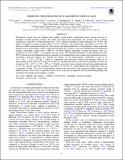Files in this item
Observing the formation of flare-driven coronal rain
Item metadata
| dc.contributor.author | Scullion, E. | |
| dc.contributor.author | Rouppe Van Der Voort, L. | |
| dc.contributor.author | Antolin, P. | |
| dc.contributor.author | Wedemeyer, S. | |
| dc.contributor.author | Vissers, G. | |
| dc.contributor.author | Kontar, E. P. | |
| dc.contributor.author | Gallagher, P. | |
| dc.date.accessioned | 2016-12-21T17:30:10Z | |
| dc.date.available | 2016-12-21T17:30:10Z | |
| dc.date.issued | 2016-12-20 | |
| dc.identifier | 247838584 | |
| dc.identifier | a0ba30f6-f46c-4fbf-8257-175cd1d33b61 | |
| dc.identifier | 85008168517 | |
| dc.identifier.citation | Scullion , E , Rouppe Van Der Voort , L , Antolin , P , Wedemeyer , S , Vissers , G , Kontar , E P & Gallagher , P 2016 , ' Observing the formation of flare-driven coronal rain ' , Astrophysical Journal , vol. 833 , no. 2 , 184 . https://doi.org/10.3847/1538-4357/833/2/184 | en |
| dc.identifier.issn | 0004-637X | |
| dc.identifier.other | BibCode: 2016arXiv161009255S | |
| dc.identifier.uri | https://hdl.handle.net/10023/10001 | |
| dc.description | PA. GV are funded by the European Research Council under the European Union Seventh Framework Programme (FP7/2007-2013) / ERC grant agreement nr. 291058 | en |
| dc.description.abstract | Flare-driven coronal rain can manifest from rapidly cooled plasma condensations near coronal loop-tops in thermally unstable post-flare arcades. We detect 5 phases that characterise the post-flare decay:heating, evaporation, conductive cooling dominance for ~120 s, radiative/ enthalpy cooling dominance for ~4700 s and finally catastrophic cooling occurring within 35-124 s leading to rain strands with s periodicity of 55-70 s. We find an excellent agreement between the observations and model predictions of the dominant cooling timescales and the onset of catastrophic cooling. At the rain formation site we detect co-moving, multi-thermal rain clumps that undergo catastrophic cooling from ~1 MK to ~22000 K. During catastrophic cooling the plasma cools at a maximum rate of 22700 K s-1 in multiple loop-top sources. We calculated the density of the EUV plasma from the DEM of the multi-thermal source employing regularised inversion. Assuming a pressure balance, we estimate the density of the chromospheric component of rain to be 9.21x1011 ±1.76x1011 cm-3 which is comparable with quiescent coronal rain densities. With up to 8 parallel strands in the EUV loop cross section, we calculate the mass loss rate from the post-flare arcade to be as much as 1.98x1012 ± 4.95x1011 g s-1. Finally, we reveal a close proximity between the model predictions of 105.8 K and the observed properties between 105.9 K and 106.2 K, that defines the temperature onset of catastrophic cooling. The close correspondence between the observations and numerical models suggests that indeed acoustic waves (with a sound travel time of 68 s) could play an important role in redistributing energy and sustaining the enthalpy-based radiative cooling. | |
| dc.format.extent | 24 | |
| dc.format.extent | 12649208 | |
| dc.language.iso | eng | |
| dc.relation.ispartof | Astrophysical Journal | en |
| dc.subject | Sun | en |
| dc.subject | Methods: observational | en |
| dc.subject | Methods: data analysis | en |
| dc.subject | Techniques: image processing | en |
| dc.subject | Techniques: spectroscopic | en |
| dc.subject | Telescopes | en |
| dc.subject | QB Astronomy | en |
| dc.subject | QC Physics | en |
| dc.subject | NDAS | en |
| dc.subject.lcc | QB | en |
| dc.subject.lcc | QC | en |
| dc.title | Observing the formation of flare-driven coronal rain | en |
| dc.type | Journal article | en |
| dc.contributor.institution | University of St Andrews. Applied Mathematics | en |
| dc.contributor.institution | University of St Andrews. Pure Mathematics | en |
| dc.identifier.doi | https://doi.org/10.3847/1538-4357/833/2/184 | |
| dc.description.status | Peer reviewed | en |
| dc.identifier.url | https://arxiv.org/abs/1610.09255 | en |
| dc.identifier.url | http://adsabs.harvard.edu/abs/2016arXiv161009255S | en |
This item appears in the following Collection(s)
Items in the St Andrews Research Repository are protected by copyright, with all rights reserved, unless otherwise indicated.

